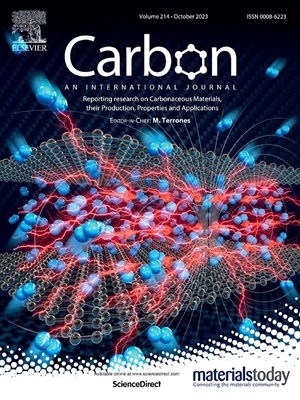Ternary deep eutectic solvent-Mediated rapid extraction of highly crystalline cellulose enabling closed-Pore regeneration of hard carbon anode for ultrafast sodium storage
IF 10.5
2区 材料科学
Q1 CHEMISTRY, PHYSICAL
引用次数: 0
Abstract
Biomass is a high-quality precursor for synthesizing advanced hard carbon (HC) anode materials for sodium-ion batteries. The challenges of developing biomass-based hard carbon anode with excellent electrochemical performance are the regulation of closed-pore structures during the carbonization. In this work, a mild deep eutectic solvent of ChCl/EtG/H2SO4 (CEH) based on ethylene glycol system is used to treat moso bamboo (MB) for the first time, which selectively dissolves most of the lignin and hemicellulose by breaking the hydrogen bonds to retain highly crystalline cellulose, thus improving the concentration of closed-pore structures in the carbonization. The as-prepared hard carbon material of CEH-MB-120/4 h possesses a rich closed-pore structure and ultrathin disordered pore walls with abundant active sites, which enables the fast ion diffusion kinetics and excellent reversibility of sodium storage. Importantly, without conductive additives, the CEH–HC–120/4 h anodes possess excellent electrochemical properties, including an impressive reversible capacity of 348.6 mAh g−1 at 0.1C, outstanding rate performance of 201.4 mAh g−1 at 10C and exceptional cycling stability with a capacity retention of 90 % over 300 cycles at 1C. This refined approach offers a facile manipulated pathway for designing biomass-based hard carbon anode with high capacity and rate performance for sodium-ion batteries.

三元深共晶溶剂介导的高结晶纤维素快速萃取,实现硬碳阳极的闭孔再生,用于超快钠储存
生物质是制备钠离子电池高级硬碳负极材料的优质前驱体。开发具有优异电化学性能的生物质硬碳阳极面临的挑战是在炭化过程中对闭孔结构的调控。本文首次采用基于乙二醇体系的ChCl/EtG/H2SO4 (CEH)轻度深共晶溶剂处理毛竹(MB),该溶剂通过破坏氢键选择性溶解大部分木质素和半纤维素,保留高结晶纤维素,从而提高了炭化过程中闭孔结构的浓度。制备的CEH-MB-120/4 h硬碳材料具有丰富的闭孔结构和超薄的无序孔壁,具有丰富的活性位点,使得离子扩散动力学快,钠储存的可逆性好。重要的是,在不添加导电添加剂的情况下,CEH-HC-120/4 h阳极具有优异的电化学性能,包括0.1C时348.6 mAh g - 1的可逆容量,10C时2010.4 mAh g - 1的出色倍率性能和卓越的循环稳定性,在1C下300次循环时容量保持率为90%。这种改进的方法为设计高容量、高倍率性能的生物质硬碳阳极钠离子电池提供了一种简单的操作途径。
本文章由计算机程序翻译,如有差异,请以英文原文为准。
求助全文
约1分钟内获得全文
求助全文
来源期刊

Carbon
工程技术-材料科学:综合
CiteScore
20.80
自引率
7.30%
发文量
0
审稿时长
23 days
期刊介绍:
The journal Carbon is an international multidisciplinary forum for communicating scientific advances in the field of carbon materials. It reports new findings related to the formation, structure, properties, behaviors, and technological applications of carbons. Carbons are a broad class of ordered or disordered solid phases composed primarily of elemental carbon, including but not limited to carbon black, carbon fibers and filaments, carbon nanotubes, diamond and diamond-like carbon, fullerenes, glassy carbon, graphite, graphene, graphene-oxide, porous carbons, pyrolytic carbon, and other sp2 and non-sp2 hybridized carbon systems. Carbon is the companion title to the open access journal Carbon Trends. Relevant application areas for carbon materials include biology and medicine, catalysis, electronic, optoelectronic, spintronic, high-frequency, and photonic devices, energy storage and conversion systems, environmental applications and water treatment, smart materials and systems, and structural and thermal applications.
 求助内容:
求助内容: 应助结果提醒方式:
应助结果提醒方式:


